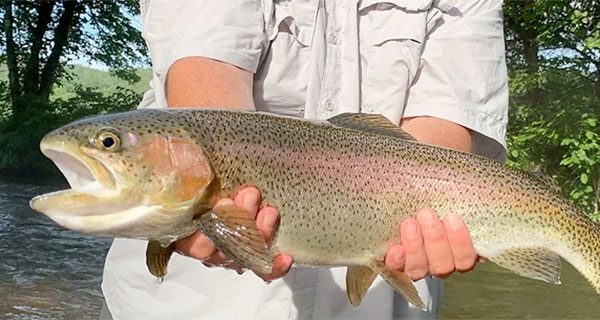The month of June begins the terrestrial season in the Southeastern mountains. Sure, there are a few tan caddis, Light Cahills and Yellow Sallies bouncing around, but the “accidentals” will draw even the largest fish in for a snack! Big bugs like grasshoppers, beetles, ants, and bees are up on top of the menu.
There’s a lot more calories in an insect this size than a teeny, little morsel and the trout and also warmwater fish like bream and bass know it. These flies not only work well, they are a blast to fish! By blast I mean the way the fish smash them on the surface. There’s no sipping a grasshopper or a big fat beetle; it’s total destruction from the food chain. Water spraying out onto the bank during the strike is commonplace adding a visual spectacle to the day not soon forgotten.
Being careful with the presentation is not necessary and sometimes detrimental. Plopping the fly down on the water can sometimes lure a trout or bass from several feet away and twitching it afterward can further seal the deal. Hopper patterns work well when there is well, grass or open areas which are hard to find on our public trout streams here in the Southeast.
Private water, pay to play streams are usually on lower elevation, more open areas, and big hopper patterns or Chubbies can be lethal and loads of fun. Lakes or slow-moving rivers containing largemouth and bluegill cruising the banks are wonderful sport with a big grasshopper or cricket fly pattern.
On our more mountainous public National Forest lands or in the Smokies, flies such as beetles, ants, or bees are more familiar to a trout. Not to say there aren’t a few small woods hoppers in the forest but there are far more other types of trout food. Parachute Black Ants are flies that even bridge the gap on hatches or at other times of the year and are a must have for an Appalachian trouter’s fly box. I’ve caught trout in January on ants and beetles during an unseasonably warm day on several occasions. They must taste good and are almost irresistible to a trout given the right circumstance.
Tying flies with foam makes them almost unsinkable and properly tied beetle patterns can be used all day without constant retreatment. Foam is a perfect material for terrestrials providing bulk with good solid profiles perfect for beetles and other bugs. Dropping a little black ant behind a beetle is a killer combo late spring all the way to fall here in the mountains. One of my best deep woods flies for summer is a simple little yellow jacket pattern tied with black and yellow foam.
Watching for hornet and bee’s nest while fishing in summer is as important as watching your footsteps for snakes. In almost every overhanging blooming Rhododendron there will be lots of various bees buzzing about and some usually wind up taking a swim. The hungry trout will take advantage of this situation.
Summer has begun and the fishing is fantastic!
Give David & Becky Hulsey a call at (770) 639-4001 to book a class or a guided trout trip. See his website at www.hulseyflyfishing.com
